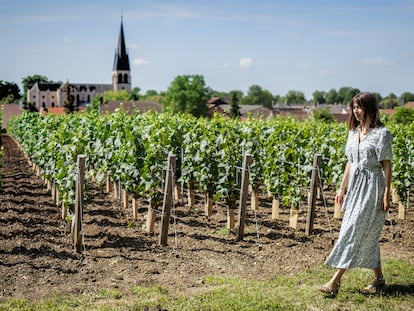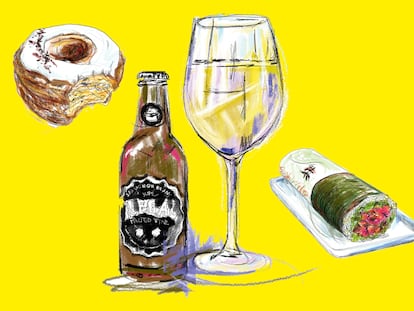Are we running out of champagne? This holiday season’s drama
In the midst of real shortages caused by climatic factors, growing demand and constant speculation and price hikes, we’re arriving at the end of 2023 with limping stock and champagne having become a global object of desire
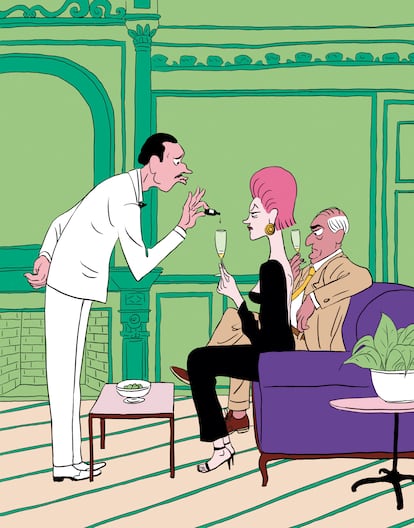
We live in strange time, amidst natural disasters and wars, and champagne — they say — is once again about to run out. We’re popping more bottles than ever. Demand is high and money flows more abundantly than even the sparkling French wine itself. For the third year in a row, the grand old champagne producers are floating the idea of a shortage. Their best customers, anxious and thirsty, hoard, speculate and run up prices.
The world’s biggest market is France, which consumes 49 million bottles a year. The United Kingdom is next, with 30 million; United States, with 17; Germany, with 15; Belgium and Japan, with 9. “Over the past two years, Spain has gone from drinking 3 million bottles annually to 4.5 million,” says Rafael Sandoval, sommelier at Madrid restaurant Coque. In contrast, supply has stayed more or less the same: 300 registered champagne producers and 15,000 family vineyards. Sandoval knows the market well. In his opinion, recent talk of shortages is “a sales strategy.”
The sommelier is referring to the wine-growing region of Champagne: 131 square miles of vineyards, likely the most expensive in the world. David Robledo, sommelier at the Relais & Châteaux restaurant group’s eatery Robuchon Madrid, calculates that .004 square miles in this area could be worth $3.2 million. Three years ago, this price was around $1.1 million. The only wine that can rightly be called champagne is made with the grapes of one of its 319 villages. A 1927 law classified these vineyards and established the grand cru category as its highest rating. Only 17 villages covering 11.6 square miles have achieved this honor. This is where the world’s most expensive and hard-to-find bottles come from, the ones that are “cellared” and collected as financial assets.
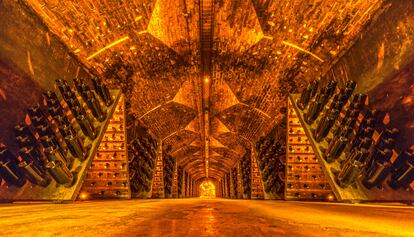
During the pandemic, the Interprofessional Committee of Champagne Wine (CIVC) sought to get ahead of a hypothetical market crash and cut production by 20%. But as we live in strange times, consumption took off. Between 2020 and 2021, sales increased by 64%. In 2022, records were broken in both global consumption with 326 million bottles — 82 million more than in 2020 — and sales, ringing in at 6 billion euros. While consumers went mad for bubbles, nature stepped in with a 2021 full of adverse weather and a resulting scarce harvest. Thus, we have reached the end of 2023 with limping stock and champagne having become a global object of desire.
“Demand has grown and there is a certain cannibalization of production and distribution among the large brands. That has resulted in a market that is more centralized and less free,” says Carlos Bosch, founder of El Portal gastrobar and the first Krug ambassador in Spain (there are only 80 in the world). Having been a brand ambassador since 2015, he is guaranteed a few bottles a year, but he says that large buyers speculate, turn off supply, allocate less bottles per country and run up prices.
Silvia García, head sommelier of Madrid’s Mandarin Oriental Ritz, is in charge of the wine cellars that supply the hotel’s five restaurants. She says that she started to stockpile beginning in June in order to make sure there was ample champagne for the holiday season. “We must not run out of Krug here, because it is the wine of choice for many customers. But it’s in short supply, and you have to go out looking to buy it from other places.”
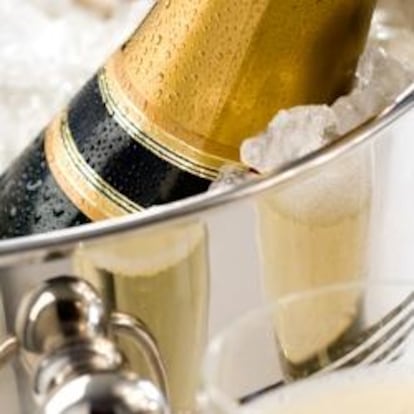
Carlos Bosch explains champagne’s rising tide of success. “Large brands like Dom Pérignon, Krug and Ruinart are on everyone’s lips. There’s more consumption in a leisure context and it’s overtaken distilled liquors, these days it’s much more than a toasting wine. In Asia, they’ve discovered champagne, which has benefited from an association with classic European luxury. People prefer to invest 70 euros in a bottle of champagne than on four cocktails,” he says.
Some experts are fervently bidding on the world’s last few bottles of Salon. The champagne comes from the mythic cru Le Mesnil-sur-Oger’s sole two-and-a-half acres of chardonnay, and from a single terroir, the Côte des Blancs, which was cultivated since 1905 by one man, Eugène-Amié Salon. At least, so goes the story of the site, property of the Laurent-Perrier group since 1989. In the cellars of the Ritz, Silvia has two of its finest vintages, 1982 and 1986. “Every time I sell one it hurts my heart because when it’s out, we won’t be able to get more,” she says. The price of a bottle stands between $4,300 and $6,500.
“We’re one of the few markets in which there is no negotiation,” says Sandoval. “Everything is exclusive, the clientele is educated and demanding, a lot is bought as an investment, and no one is looking for an affordable champagne. In Coque, the most expensive sparklings are the ones that sell the best,” says Sandoval, saying that the most valuable bottle in his cellar is a 2002 Krug, with a $4,300 value, a 1996 Salon and a few editions of Dom Pérignon.
The Ritz sommelier has been surprised by the shifting rituals of champagne. A very young couple ordered a Krug. Then, in a hushed voice and after a lot of skirting the subject, they told her that they would drink it in a brandy snifter, with crushed ice and a Red Bull. Anathema? Sacrilege? “I don’t get paid to judge, only to bring happiness,” she says. “Champagne consumers are getting younger all the time. 15 years ago, people ordered it less and used it exclusively to toast. Now it can be paired with meat, fish and even a cocido [Spanish stew],” she says. She particularly recommends this last pairing. David Robledo, the sommelier at Robuchon and — he confesses — an avid champagne consumer, agrees that the wine may be drank from the appetizer to dessert course. Carles Bosch points to its aspirational factor. “It’s an elitist beverage, but also has a lower alcohol percentage than a distillate, and that elevates its prestige because it feels good and hardly leaves a hangover.”
Robledo says that in Champagne there are entire families who live on the sales of five to seven acres of a highly rated vineyard. The children and grandchildren of the winegrowers who once rented their lands to the larger producers have studied, traveled and now produce their own champagne. “They are wines that vary widely, that have more personality, in which the land stands out much more than the cellar,” he says.
The arrival of the singular sparkling wines that come from these vignerons has changed the market and has given rise to real cult products, expensive and impossible to find. All the experts consulted for this article mention the Selosse. This is the moniker of champagne from Jacques Selosse’s cellar, which has been managed by his son since 1974: nearly 15 acres of champagne mainly located in the village of Avize, and 2.2 acres of pinot noir. All of their vineyards are rated grand cru.
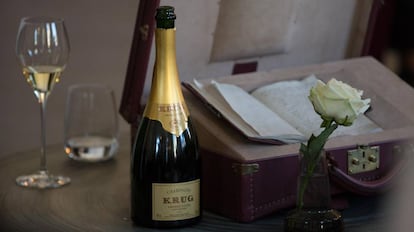
Florent Mercier is the founder of Champerón Paris, a business that has distributed some of these cult sparklings in Spain for a decade. “Small artisanal cellars have expanded the range of tastes and smells, and have made the market more attractive. There are between 10,000 and 20,000 annual bottles for the entire world, and they are distributed by annual quotas established by the winery itself.” Apart from Selosse, Mercier lists La Closerie and Frédéric Savart among the most desired independent winemakers.
If Rafa Sandoval only had a few hours to live, he’d go down to his cellar and open up a 1973 Dom Pérignon Plénitude 3. David Robledo would prefer a 1966 Salon Cuvée Le Mesnil magnum. He doesn’t have it in his cellar because it is almost sold out worldwide, but if he did, he would drink it with religious devotion. The sommelier is against using champagne flutes because they “lose aromatic expression,” and is likewise opposed to very cold wine, so he would celebrate life in a wide glass, always served above 44.6 degrees Fahrenheit. Carlos Bosch would uncork a Krug grande cuvée that has spent many years in a bottle. And Silvia García, a 1982 Salon. “Without a doubt,” she says.
On a great occasion, all would toast with an antique. A priceless champagne, one of those that you hope to taste within a lifetime. Because, paradoxically, scarcity suits certain vintages of champagne quite well. There was never luxury in abundance, only vulgarity.
Sign up for our weekly newsletter to get more English-language news coverage from EL PAÍS USA Edition
Tu suscripción se está usando en otro dispositivo
¿Quieres añadir otro usuario a tu suscripción?
Si continúas leyendo en este dispositivo, no se podrá leer en el otro.
FlechaTu suscripción se está usando en otro dispositivo y solo puedes acceder a EL PAÍS desde un dispositivo a la vez.
Si quieres compartir tu cuenta, cambia tu suscripción a la modalidad Premium, así podrás añadir otro usuario. Cada uno accederá con su propia cuenta de email, lo que os permitirá personalizar vuestra experiencia en EL PAÍS.
¿Tienes una suscripción de empresa? Accede aquí para contratar más cuentas.
En el caso de no saber quién está usando tu cuenta, te recomendamos cambiar tu contraseña aquí.
Si decides continuar compartiendo tu cuenta, este mensaje se mostrará en tu dispositivo y en el de la otra persona que está usando tu cuenta de forma indefinida, afectando a tu experiencia de lectura. Puedes consultar aquí los términos y condiciones de la suscripción digital.
More information
Últimas noticias
Most viewed
- Oona Chaplin: ‘I told James Cameron that I was living in a treehouse and starting a permaculture project with a friend’
- Reinhard Genzel, Nobel laureate in physics: ‘One-minute videos will never give you the truth’
- Sinaloa Cartel war is taking its toll on Los Chapitos
- Why the price of coffee has skyrocketed: from Brazilian plantations to specialty coffee houses
- Silver prices are going crazy: This is what’s fueling the rally

